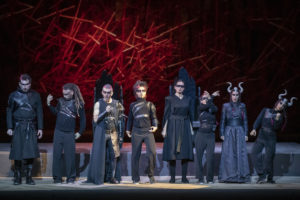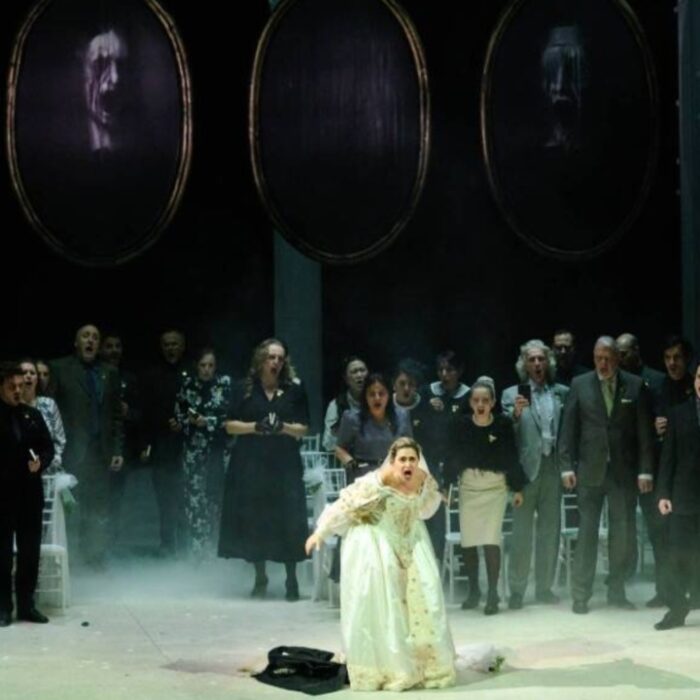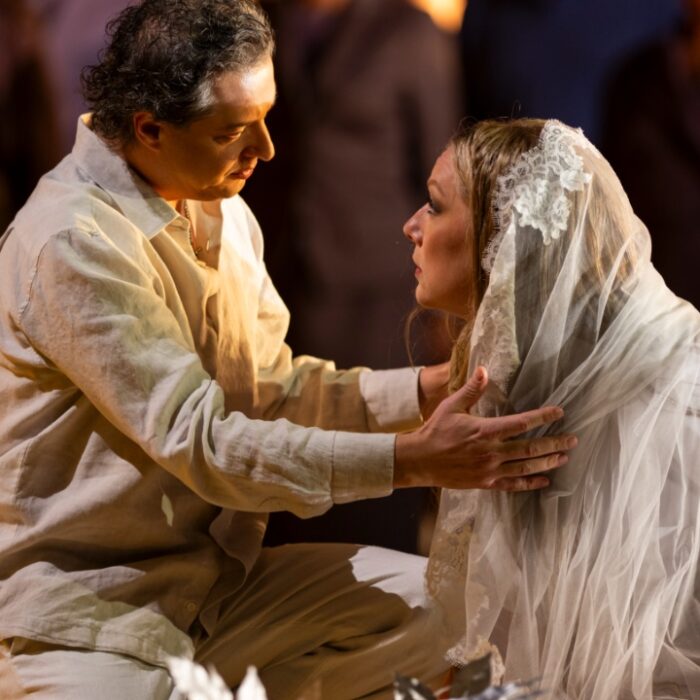
(Photo: Zani-Casadio)
The rehabilitation of Vivaldi’s operas continues apace. Over the past five or six years, the number of performances of his works has soared so that productions, which would have only recently been classed as welcome but rare events, are now becoming increasingly common. At least, that is the case in Italy and one or two other countries. It was not a great surprise, therefore, that Ravenna’s Teatro Aligheri’s first opera of 2023 was a production of the composer’s 1735 opera, “Tamerlano,” to a libretto by Agostino Piovene.
An Opera Distinguished By Inaction
The director Stefano Monti, encharged as director, scenographer, and costume designer, displayed a strong commitment in his program notes to the baroque form, which he believed resonates with today’s mindset and possesses the possibility to become “the musical theater of the future” owing to its “timeless emotional force.” Nevertheless, he also identified challenges that result from its fundamental structure of alternating arias and recitatives. While the arias are used to give voice to the character’s emotional state, they are also “interior monologues,” where the action stops, whereas the recitatives in “Tamerlano,” which are used to move the action forward, he likened to “conversations between the deaf.” In other words, it is an opera characterized by inaction.
Monti’s solution was to have each singer shadowed by a dancer, who projected their emotions and the meaning of their words, and in what was a nod to seventeenth-century Venice’s association with puppet theater, for which Vivaldi also composed music, their movements were jagged and wooden, almost robotic, although with greater fluidity and speed. It was a well-conceived idea, one for which the choreographers Marisa Ragazzo and Omid Ighani developed inventive, interesting, and, at times, amusing interpretations. The singers varied their responses to the presence of their shadow dancers; sometimes, they interacted with them; at other times, they remained fairly static, and on occasion, they would act out their roles as normal. The dancers of the DaCru Dance Company produced a high-energy, animated, and convincing performance that certainly had the effect of offsetting any static elements contained within the work. Moreover, apart from occasional overcrowding, their presence added to the pleasing aesthetic of the staging.
It was certainly an experimental approach, one that was unlikely to please the purist, but as a one-off production, it worked. However, it is likely that repeated use of dancers in this way for other productions would quickly become tiresome.
Monti was also successful in other aspects of his staging. The costumes, invariably black with flashes of red, combined past and futuristic styles that emphasized a brutal and militaristic aspect, especially in the cases of Bazajet and Tamerlano, who were also furnished with black tattoos across their faces. Each costume carried a striking, distinct feature that was worn by the shadow dancer, which was helpful in identifying the dancer.
The scenery consisted of little more than an empty stage with monolithic rock formations along the sides and a large platform in the center that was raised, lowered, and levitated. Everything was colored black. This may not sound particularly interesting nor aesthetically appealing, but the addition of strange, weird, and wonderful videos projected onto the back wall created a sense of wonder, and although the images did not appear to possess specific symbolic meanings, they resonated on a subconscious level that worked in tandem with the dramatic flow. Created by Cristina Ducci, the videos moved between various images, including, among other things, cascading skulls, a large red rose with an eye in its center, a rotating red skull, and the frame of a running horse pierced by daggers or crosses. On occasions, the imagery had the effect of opening up space, giving the impression of a desert landscape.
If indeed, Monti was correct in identifying the opera’s problem as one of inaction, then he certainly was successful in rectifying the problem. His bold decisions ensured that there were rarely any scenes that lacked movement and energy, and they were presented in a way that held the audience’s attention.
Dantone’s Masterful Musical Direction
As with many operas of the time, “Tamerlano” is a pasticcio, a work cobbled together using music from Vivaldi’s past operas as well as arias by Giacomelli, Broschi, and Hasse. Vivaldi’s only new compositions for the opera were its recitatives.
Those readers familiar with Ottavio Dantone’s 2019 recording for the Vivaldi Edition will also be aware that the original score was missing five arias, for which only the texts exist. Dantone’s solution was to reset them to existing music by Vivaldi, Hasse, and Broschi, and it was this version of the opera that was performed, with Dantone directing the Accademia Bizantina as in the recording.
Such is his intimate familiarity and sensitivity to the nuances and practices of Italian baroque music and to Vivaldi, in particular, that a first-rate performance is almost assured, especially when he is supported by an ensemble as accomplished as Accademia Bizantina, whose playing was crisp and precise throughout, which gave the music a clearly defined shape. From the opening sinfonia, his sensitivity to the music was clearly evident as he attacked the musical line in typical Vivaldian style, infusing it with a rhythmic vitality and energy that he unleashed throughout the performance, which he contrasted with calmer, more tender, or reflective passages to meet the changing dramatic circumstances.
It was interesting to note how even though the voices of different composers were clearly audible, Vivaldi and Dantone had the skill to combine them to create a unified whole.
A Top Quality Cast
However, it was not just the quality of Dantone and the Accademia Bizantina that stood out. The cast was also excellent. Every role was parted with a high-quality singer with a strong pedigree in performing baroque opera.
Tamerlano was parted by countertenor Filippo Mineccia, who also performed the role on the Vivaldi Edition recording. He essayed the role with the confidence and swagger of someone who knew exactly what they were doing, which added to his character’s domineering personality and magnified his authority. Visually, he cut a menacing figure with his aggressive costume, tattooed face, and red and black-colored hair. His singing, both of the arias and recitatives, was forceful and expressive, in which his use of coloring, dynamic contrasts, and well-placed accents brought out their full emotional meaning. His ability to control his voice and maintain its quality under pressure was also impressive.
Of his four arias, two were by Giacomelli, one by Hasse, and one by Broschi, with none by Vivaldi. It is an eclectic mix, but it actually worked in promoting a clear image of Tamerlano’s character with his fast-changing, even unstable emotions, which were prone to extreme actions.
His adversary, Bazajet, was played by baritone Gianluca Margheri. Displaying a strong stage presence and costumed not too dissimilarly from Tamerlano, he also appeared as an aggressive warrior-type, capable of violence and extreme behavior. Margheri possesses a rich, resonant voice with a pleasing degree of versatility that allowed him to successfully defined his Tamerlano as a determined, inflexible, vengeful, and self-centered individual who would happily sacrifice everything and anyone, including himself, to achieve his aims.
Federico Fiorio, in the role of Andronico, is a very different countertenor to Mineccia, yet equally convincing. Rather than seeking to express his emotions in an energetic, florid and animated manner, Fiorio centered his presentation on precision and accuracy, in which vocal beauty and sensitivity to detail were clearly important. It did not mean, however, that expression was relegated to a secondary concern, only that it flowed naturally from the way he engaged with the music and the text. In his aria “Spesso tra vaghe rose,” for example, Andronico gives voice to his passionate feelings for Asteria and his inability to escape his emotions, no matter the cost. Fiorio produced a versatile, complex vocal display full of subtle embellishments and passages of intricate coloraturas. There was nothing forced, nothing flashy. The overriding impression was one of grace, beauty and sensitivity, but not at the expense of failing to communicate his character’s emotions, which were clearly portrayed.
Contralto Delphine Galou, parted as Asteria, was another singer who also appeared in her role on the Vivaldi Edition recording. She is a singer with excellent technique. Each line is carefully molded with precision, which was particularly notable in the lighter or reflective arias, in which she is consistently excellent. Her rendition of “Amare un’alma ingrata” was a delight. Her singing was controlled, secure, and sensitive to the text, while her light coloratura sparkled. Yet, on occasions, especially in the more highly charged arias, there is an emotional reserve that undermines the effect, and one can be left with the feeling that she is, perhaps, too precise, too careful, and lacking the necessary spirit. Even in such cases, however, it is still possible to admire her technique and vocal beauty.
Soprano Marie Lys was cast as Tamerlano’s throwaway bride, Irene. Lys is a singer who engages wholeheartedly with her character. In this case, she was strong, emotionally stable, and focused. She possesses an impressive coloratura, which she unleashes with a sense of freedom, even abandonment, although never allowing it to run out of control. Such is her vocal versatility that complex passages, including leaps, were taken in her stride. Although she had only three arias to sing, all grabbed the audience’s attention. It was, however, the final aria, “Son tortorella,” which made the most immediate impression, in which she not only delivered captivating passages of coloraturas, and cooed like a dove in a pleasing piece of word painting but in one section, she sang without musical accompaniment, which revealed the full beauty of her voice.
The cast was completed by mezzo-soprano Guiseppina Bridelli in the role of Idaspe. She possesses a resonant voice with an attractive timbre, which in the upper register has a bright, pure quality to it. It is also a versatile voice that moves easily across the range. Although Idaspe is a peripheral character and not particularly interesting, Bridelli certainly made the most of it, putting in a strong, high-quality performance in which her arias were all exceptionally well-presented. Her arias “Anch’il mar per che sommerga” and “D’ira e furor armato” allowed her to show off her vocal versatility as she spun out attractive and ornately embellished lines and dazzled with her intricate passages of coloratura, while “Nasce rosa lusinghiera” highlighted her innate lyricism and vocal beauty, which she successfully combined with expressive honesty.
This “Tamerlano” production was an unmitigated success, and the audience loved it. It now moves on to other cities across northern Italy. Catch it if you can. You will not be disappointed!



